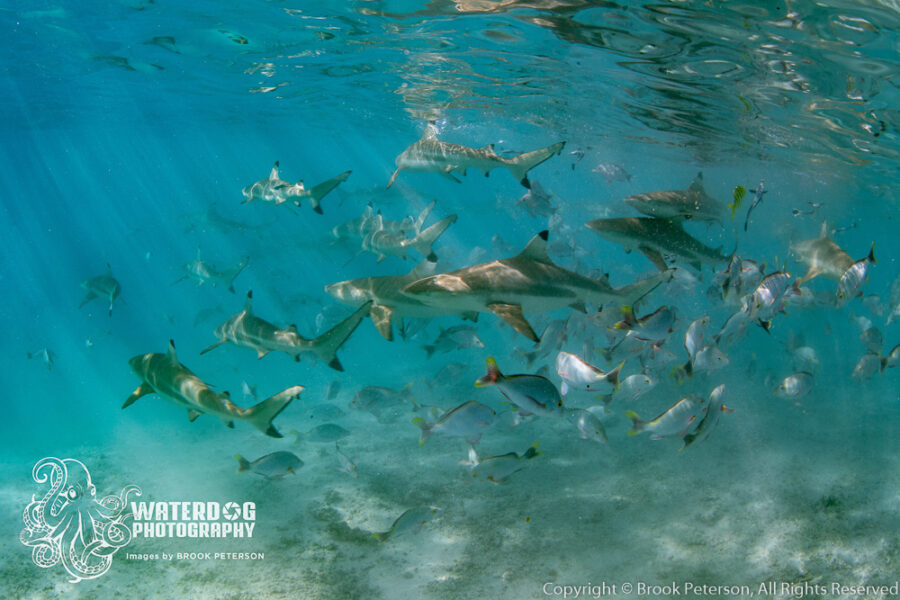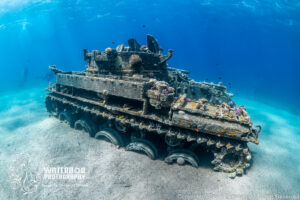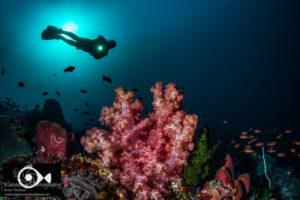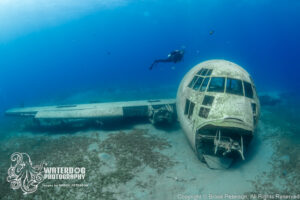A thrill went through me as I listened to the briefing before the dive. This dive would be a singular experience, rare as a hen’s tooth, and one I had anticipated for several years. Happening just once a year, by the light of the full moon, an event of epic proportions takes place in the South Pacific. Weeks before the event marbled grouper make the journey from the open ocean and the bays of the atolls of French Polynesia to the South pass of Fakarava. Here they will spawn for just one hour on one night. Hundreds of thousands of fish gather together to take part in the orgy and for some, it means a violent death.

Fakarava is a well-known destination for divers who want to see sharks. My journey began with a flight to Tahiti, and then a connection to Rangiroa, one of the Tumotu group of atolls. There, I boarded the Tahiti Master, a liveaboard dive boat, where I would spend the next ten days diving among the large predators of the sea.
Although the itinerary included diving at several atolls before reaching Fakarava, our goal was to arrive at the South pass a few days before the full moon in June. This would allow us time to observe the grouper that were gathering and make a prediction as to when the spawning might occur.
Divers were divided up in groups of five and each group was assigned a guide. According to French law, divers may not dive without a guide. This proved to be a great advantage to us, as our guide was very knowledgeable about the grouper. A skiff took us to the mouth of the South pass where we did a back roll into the waves. There is always current in the pass, and our decent to 30 meters was reminiscent of an amusement park ride. Down through the crystal blue water, we soared over a reef writhing with fish. Like a carpet, they blanketed the ocean floor.

It was two days before the full moon and already there were a great number of grouper in the pass. Some of the males were fighting with each other while the females looked on with interest. Female grouper are somewhat darker than the males. They carry the eggs in their bellies but on this day their bellies did not look at all swollen. Our guide explained that the eggs are dry at first. As the spawning time draws near, the female will bring water into her body, soaking the eggs. As the eggs hydrate, they will swell, making her belly bulge. Because of this phenomenon, the exact hour of spawning is not as hard to predict as one might think.

The full moon causes larger tides. As the tide comes in, the water rushes in through the pass of the atoll, filling the lagoon. When the tides recede, the lagoon empties through the pass causing a rushing current back out to open ocean. The fish will spawn on this outgoing current during the early morning hours of the day, on or near the full moon. To predict the spawning, one only has to observe if the female grouper are starting to show a bulging baby bump. If they are, the spawning will likely take place early the following morning on the outgoing tide.

French Polynesia is known for its great number of sharks. Sharks near Fakarava number in the thousands. During the day they swim passively through the water column but at night a vicious feeding frenzy takes place on the reef. Like a pack of wolves, the sharks hunt in large numbers for reef fish. The grouper which have gathered in such large numbers are now their number one prey.

Prerequisite to a dive during the spawning event is a night dive with feeding sharks. This allows a diver to observe shark feeding behavior without the distractions of the breeding grouper. A night dive, among feeding sharks can be a dangerous dive and is not for the inexperienced diver. One must wear black from head to toe, including black fins, gloves, and hood. Perfect buoyancy control is a must and the diver must not be prone to panic. I will admit to a degree of apprehension before my night dives with feeding sharks. As we descended in to the dark our lights illuminated the reef like a lightning bolt in the dark and exposed some of the reef fish in their hiding places. Sharks swarmed around us and it was necessary for us to hunker down on the reef without moving to observe their hunt. When one shark discovered a fish, it would pursue it into the reef where many other sharks would follow. A group of sharks can turn a part of the reef to rubble in a matter of minutes as they fight over their prey. A diver must not get caught in this melee if they want to keep all limbs intact.

It was also necessary for us to gain some experience diving on an outgoing tide with the grouper as the current was very swift and a diver who is swept out to sea may have a difficult time getting rescued. The combination of grouper spawning and sharks feeding on them while trying to maintain buoyancy and control during a swift current in the wee hours of the morning would be an experience I will never forget.
On the day before the full moon we noticed the bellies of the grouper were beginning to bulge. There were also twice as many grouper as the day before. We anticipated the spawning would take place at 4:30 A.M. the next morning, when the tide turned, and the current would swiftly sweep the eggs out to sea. Our wakeup call was for 3:30 in the morning so we could be prepared to descend into the dark water by 4:30, the height of the tide and thus the beginning of the outgoing current.

The time finally arrived, and I followed my group down into the dark to the bottom of the pass where I placed my reef hook to keep me from flying away with the current. The fish were visibly excited. Many of the males were biting at each other and occasionally they would bite at the side of the females. The show soon began. Males would present themselves to a female and do a quivering dance, enticing them to mate. Sharks circled above, waiting for the grouper to shoot up into the water column. As they mate, they look like fireworks. One female followed by several males would spawn together in a tight circling dance up and up to the waiting sharks. Swiftly, the lucky ones shoot unharmed back down to the protection of the reef. The entire event only lasted a few seconds. Many made it back to safety, but some were not so lucky.

With the swift current and the depth of the dive, we were only able to stay down for about 40 minutes to enjoy the spawning. We were very lucky to have timed it right. By the time the sun began to rise it was over. Our next dive would be later in the morning where we would learn the harsh fate of many of the remaining grouper. The carpet of fish was already beginning to disperse. Many surviving grouper were missing body parts or had large bite marks from the sharks. They were the lucky ones for one more night. Their wounds would make them easy prey once the sun set again.


The aggregation of grouper in Fakarava is one of the largest known in the world. To experience it, a diver must be well prepared for difficult if not hazardous conditions. The grouper risk their lives to procreate and thousands of sharks are presented with a yearly feast. It is a thrilling experience for everyone involved, including the humans who are there to observe.
Join me for a workshop! Travel to a great destination where you will have exclusive coaching on your underwater photography. Meet new people, network, try new techniques, and learn with the pros! Click on Travel and Workshops for more information!
Subscribe now!
As always, if you enjoy my images please visit my website, waterdogphotography.com, or give me a like on Facebook at Waterdog Photography Brook Peterson. Don’t forget to follow me here at waterdogphotographyblog and please feel free to share on Facebook or other social media.
My photographs are taken with a Nikon D850 in Sea and Sea Housing using two YS-D2J Strobes.
All images and content are copyright protected by Brook Peterson and may only be used with written permission. Please do not copy or print them. To discuss terms for using these images, please contact me.
© Brook Peterson 2019






